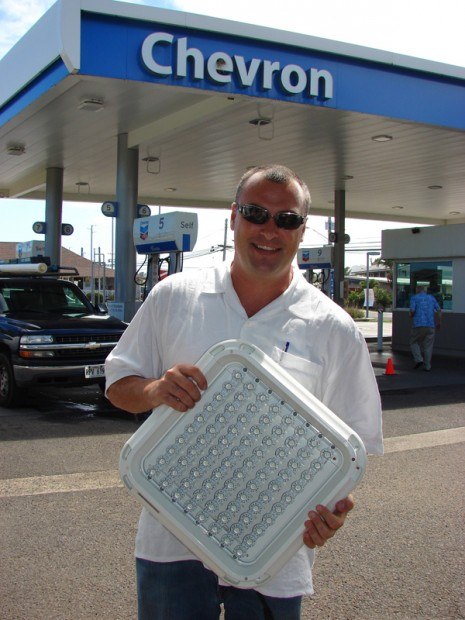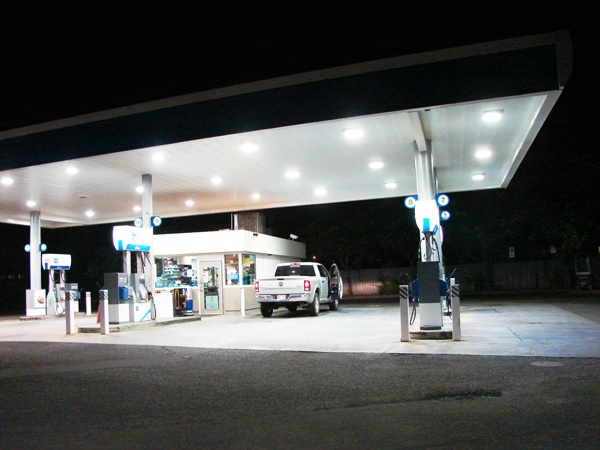KAPA‘A — It’s not easy being the first to make a big change, but unquestionable savings and incentives were enough to make Kapa‘a Chevron the first gas station on Kaua‘i to convert to LED lighting.
“The savings was about 75 percent energy savings on all of the lights that we affected,” said Anthony Mitchell, managing director of Eco Green Solutions in Laguna Niguel, Calif.
The canopy and refrigeration light replacement amounted to about an 80 percent savings, while the fluorescent replacements were about a 55 percent savings, Mitchell said. Those savings add up at a place where most of the lighting is on around 12 hours a day or more.
“It was a huge payback for the customer,” Mitchell said.
The incentive to change over now is not merely monthly utility costs. There is a federal tax incentive for a percentage of value on the old fixtures, and a 50 percent match for materials from Kaua‘i Island Utilities Cooperative.
The incentives combined with estimated utilities and maintenance savings on the $36,000 project will see a total return of investment for the entire project in about nine months, Mitchell said.
“The whole picture is a huge savings for everybody,” he said.
Roy Hoyt, who was a Chevron representative on Kaua‘i from 1960 to 2000, is now an oil industry consultant approaching 47 years of service. He worked with Mitchell to open doors to Lahaina Petrolium’s Chevron stations and with other companies in Hawai‘i and on the Mainland.
“I am the matchmaker,” he said. “Things always work better when you work as a team.”
Hoyt joked that when he told station owners he could get them $80,000 worth of environmentally sound lighting at no expense, they replied that he was finally getting too old for the job.
“They now know it’s good for the environment and that it reduces 65 percent of emissions,” Hoyt said. “The employees are also saying the light is better and that it is more natural with less strain on the eyes.”
KIUC Communications Manager Jim Kelly said EcoGreen is an Energy Wise program which offers an evaluation of a customer’s energy usage followed by recommendations on how they can use electricity more efficiently.
“This service is available to residential and commercial customers, like the Chevron station,” Kelly said. “Our staff has been working closely with EcoGreen and the station’s owners for some time on this project.”
Every project is different and the amount of the incentives KIUC can offer varies, depending on the equipment and the projected savings, he added.
“In this case, KIUC is covering part of the cost of installing an energy-saving LED lighting system,” Kelly said. “That will not only save the customer money but will reduce the amount of power our system has to generate, meaning we’ll burn less oil.”
Mitchell is talking to owners of oil companies, hotels, schools, restaurants, factory and warehouses, all of which have 24 hour lighting and could benefit from LED.
“Its good for Chevron and our community to be saving money,” said Chevron Assistant Manager Crystal Chow, who added that her own house is totally photovoltaic.
“Yay Chevron for going forward and doing that.”
The 100 watt outdoor light panels last about 10 times longer than the original 368 watt lights that are replaced every 18 to 24 months, Mitchell said, noting a $400 savings in equipment and labor.
The Eco Green LED light fixture is made of aluminum. It is a series of silicon lenses is powered by individual electronic units.
The lights are guaranteed for five years or 167,000 hours. Most companies guarantee around 50,000, Mitchell said.
He said Eco Green offers more than 200 products ranging from omni-directional lighting to various types of temperature and color.
Mitchell said Eco Green made the investment to become certified with the Department of Energy and utilities commissions. He said the products were tested for durability, shock, vibration, wind and a 3,000 hour salt test.
Unlike the old lighting, LED has no mercury, lead or other harmful elements, he said. It can be disposed of without concern for hazardous waste, but should recycled as aluminum.
“There is a lot of junk out there so be sure it is certified and guaranteed,” he said. “Everything will have to be converted at some point and right now there are government funds set aside to incentivize the process.”
• Tom LaVenture, staff writer, can be reached at 245-3681 (ext. 224) or by emailing tlaventure@thegardenisland.com.



